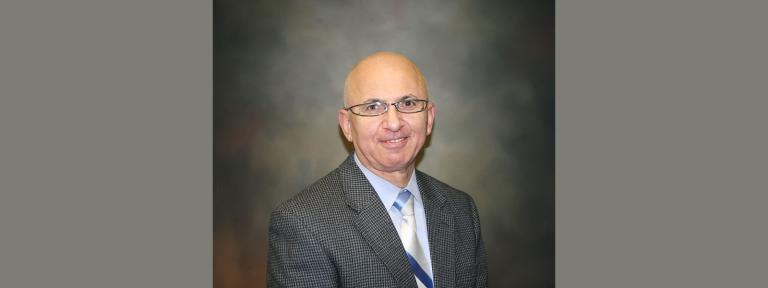
In what he termed a counter-intuitive maneuver, Dr. Homayun Navaz, professor of Mechanical Engineering at Kettering University, turned down the velocity of cold air and raised the temperature to 32 degrees in a refrigerated display case in an attempt to improve energy efficiency. Ironically, it worked. Not only did energy savings go up – but the food actually got colder.
“You would think more air coming faster would work better, but interestingly, the decreased velocity improved infiltration, which resulted in the food being one degree colder than before because the cold air was distributed more efficiently and evenly inside the display case,” explained Navaz.
“Previously, manufacturers were running the power too high on open refrigerated display cases – we just lowered the power,” he said. Using a machine called the "Proof of Concept Air Curtain" (POCAC), designed and built at Kettering by Navaz, Mazyar Amin, a Ph.D. candidate, and Professor Dana Dabiri from the University of Washington, they performed a matrix of tests varying geometrical configurations and operating conditions resulting into approximately 3,000 data sets that were correlated through a computer program.
“Our computer model is based on experimental technology,” said Navaz, “we came up with a software based on Artificial Neural Network (ANN) that can accurately measure and minimize the infiltration of warm air into a display case. “The optimal infiltration rate is a narrow bridge, but easy to hit,” he said. The software Navaz and Amin are using is based on artificial intelligence, meaning it learns through experimental or numerical information, according to Navaz.
Lower infiltration means the air is coming out at a lower velocity, said Navaz. “Previously, air came out of the upper vent (or grille) of a specific display case at 90 feet per minute. We calculated the optimal speed as 65 feet per minute as an optimal discharge air velocity to yield lower infiltration rate,” he said.
By reducing the velocity by 30 percent, infiltration was reduced by 12 percent and the power required was reduced by 13 percent.
Increasing the temperature at the discharge air grille by about 1 degree (F) and lowering the velocity of air resulted in lower suction pressure at the compressor inlet which reduced the compressor usage and therefore less energy consumption.
Infiltration represents 83 percent of the cooling load and is the biggest draw on energy of refrigerated display cases. Less energy use translates into real cost savings to the tune of about $13 million for the state of California alone, according to Navaz.
This kind of energy savings also reduces CO2 emissions that cause green house gases, according to Navaz. Using California as an example, he explained it would represent a 48,783-ton reduction in CO2 emissions a year. These nationwide savings for reduced infiltration rate version of just open vertical display cases can be calculated to be about $170-200 million/year with more than 500,000-ton reduction in carbon dioxide emission.
The technique works even better in humid areas where ice builds up on the evaporator coils more frequently and the defrosting mechanism becomes activated more often, said Navaz. With less infiltration there is less ice build up and less energy to run the auto defrost function.
“We are making a known technology better, and there is a potential for huge payoff,” he said, “just multiply our results by the number of display cases used state wide, nation wide, and world wide.”
Manufacturers implementing changes based on the Kettering research are already seeing better than predicted results, according to Navaz, and so far it hasn’t cost them anything to implement the recommended changes. Edison in California conducted the field tests of Navaz’s research for manufacturers and users in the state.
In addition to energy savings, lowering the pressure on the compressor also extends the life of the compressor and creates more cost savings over the long term.
“This is not something we are promising,” said Navaz, “it is something we have done and proven.”
The Department of Energy and the California Energy Commission and Edison underwrote the research project that began 1998 with a simple computer simulation of air curtains. The total cost of the project came in just under $500,000, according to Navaz.
Partnering organizations for the cold air curtain project included: The Technology Test Center(TTC) at Edison; Public Interest Energy Research (PIER) at California Energy Commission.
The next step is researching the cold air turbulence, according to Navaz. “If we can fix it at the discharge air grille we can achieve another 10 to 15 percent improvement in energy efficiency,” he said. They will need to secure funding to perform the turbulence research.
Calling infiltration a bad thing in general, Navaz envisions making all refrigeration more energy efficient, including walk-in freezers and coolers in restaurants, horizontal refrigeration, and freezers with doors.
“There are so many in service and infiltration is a huge issue,” he said. “Imagine if we could save 10 to 15 percent in all of these what an impact what would make on energy consumption world wide.” He is currently attempting to form a consortium with Edison to not only to expanded the research, but also create jobs in Michigan by starting a center for Efficient Refrigeration Technology
Recognizing the push to develop alternative energies, Navaz believes his refrigeration research is part of a larger energy picture. “It doesn’t mean we shouldn’t develop new technologies simultaneously,” he said, “but this is an easy, very low-cost/low-risk way to help to reduce energy consumption immediately.”
Written by Dawn Hibbard
810.762.9865
dhibbard@kettering.edu